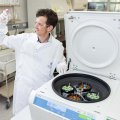Researchers develop ways to keep cattle cool
University of Queensland Gatton College researchers have developed a prototype of an early warning device for heat load among cattle.
The Thermal Load Monitor is set at the animal's body temperature of 38.6 degrees Celsius and placed among herds. If heated above this level, the device can trigger cooling systems such as fans or sprinklers or set off an alarm.
It is just one of many initiatives developed as part of a four-year international research collaboration furthering understanding and management of heat load in cattle.
Overheating causes many deaths among cattle each year with productivity and reproduction affected in many more. Heat load is a problem in all mainland Australian states and territories for up to six months each year.
Professor Bruce Young, John Gaughan and Peter Goodwin from the University's School of Veterinary Science and Animal Production, have been working with American researchers to develop research and resource materials for farmers dealing with the problem.
One publication produced in conjunction with the Queensland Department of Primary Industries (QDPI), entitled Managing Hot Cows in Australia, has been distributed to farmers throughout Australia.
The project also involves several postgraduate students including PhD students Simone Holt and Anita Hall and masters student Trish Skele.
"Heat load causes cattle to stop eating and therefore to stop growing. It causes dairy cattle to stop lactating," Mr Gaughan said.
"Apart from these productivity issues, heat load causes great discomfort and even death among cattle. An animal standing in the sun on a hot day may be experiencing heat in its head of up to 65 degrees Celsius.
"The issue is also attracting increasing attention from animal welfare groups."
The research was initiated with a Dairy Research Development Corporation grant of $250,000 jointly with the Queensland Department of Primary Industries, Mutdapilly. Dr Michael McGowan, also from the School of Veterinary Science and Animal Production, Pinjarra Hills, provided the reproduction link.
Subsequent collaborative research has also involved Professor Terry Mader from the University of Nebraska, Dr Leroy Hahn from the United States Department of Agriculture and Professor Yamamoto from the University of Hiroshima.
Using a special chamber at Gatton College in which prevailing temperatures can be manipulated up to 40 degrees Celsius, the team measured respiration, heart rate, feed intake and body temperature of cattle subjected to various temperatures as well as cooling methods.
Field work in the United States and at Gatton College has focused on heat load among feedlot cattle using a special measuring device called a respiratory belt to minimise human contact effects on results. Ms Holt recently spent three months assisting an extensive feedlot trial by staff from the University of Nebraska.
The Queensland team is also developing a computer model allowing farmers to predict when combined heat and humidity are likely to cause heat load. A CD-ROM has also been produced containing a Temperature-Humidity Index for 200 Australian locations for each month of the year based on weather data collected between 1957 and 1993.
Numerous research papers and resource materials outline steps farmers can take to reduce or manage heat load including night feeding and milking, the planting of shade trees, dams for animals to stand in and making drinking water available en route to milking sheds.
Ms Skele's work previously focused on the affect of cattle colour on heat load. She found cattle with more than 50 percent of their coats coloured black suffered more in the heat. Cattle with predominantly white heads and bodies coped better with heat load as their brains were literally kept cooler, she found.
"I found predominantly white cattle produced 1.5 litres more milk than predominantly black cattle on hot days," she said.
The team said the best heat load management strategy they had seen was on a 3500-head dairy feedlot in Florida. There, fans with misters kept the air cool without muddying the ground. Special roof shades, cooling ponds and wading pools were further cooling mechanisms. Cows also waded shoulder-deep in a long bath to reach the milking area three times a day.
For more information, contact Mr Goodwin (telephone 07 54601265) or Professor Young (telephone 07 54601252).



